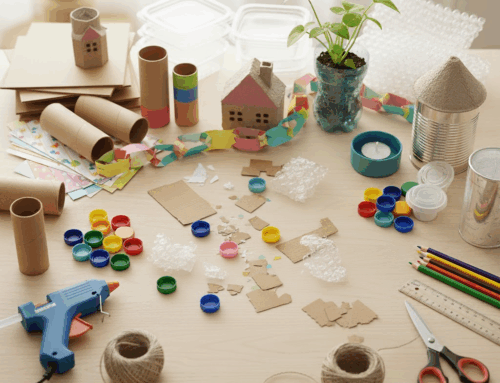Thrift donations are a simple way to reduce waste, conserve resources, and support community programs. Every year, millions of tons of clothing and furniture are discarded in the U.S., much of which ends up in landfills. By donating items in good condition, you help extend their lifecycle, cut down on landfill waste, and reduce the need for new production, which saves water, energy, and lowers carbon emissions. Plus, thrift stores like City Thrift and Goodwill use proceeds from sales to fund programs that aid local communities.
Key Points to Keep in Mind:
- What to Donate: Clean, gently used clothing, shoes, books, toys, and household items.
- What Not to Donate: Damaged, incomplete, or hygiene-related items like used mattresses, broken electronics, or stained textiles.
- Preparation Tips: Wash items, sort them by category, and label boxes or bags for easier processing.
- Impact: Donating reduces landfill waste, supports local economies, and helps fund social programs.
By donating thoughtfully and preparing items properly, you ensure they can be reused or repurposed effectively. This small effort makes a big difference in your community and helps reduce waste.
What to Donate: Guidelines for Eco-Friendly Contributions
Making smart choices about what to donate can have a real impact on reducing waste. Did you know the average American tosses out about 70 pounds of clothing and textiles every year? By donating thoughtfully, you can help redirect these items toward meaningful reuse, especially when they’re in good, wearable condition.
Items You Can Donate
Clothing and textiles are among the most common and useful donations. Clean, gently used clothing – including seasonal or professional attire – can find a second life in someone else’s wardrobe. Beyond clothing, items like bedding, curtains, and household textiles are also highly appreciated.
Shoes and accessories in functional condition, even if moderately worn, are always in demand.
Books and toys are another great category to consider. Children’s books, novels, educational materials, and board games can bring joy and learning to others. Just make sure toys include all their pieces and meet safety standards.
Items You Should Not Donate
Professional organizer Clara Schoen advises:
“We should all strive to be conscious donors – real people are working at these places, and half of what they receive is just put in the trash.”
This underscores why knowing what NOT to donate is just as important.
Safety hazards like used mattresses or box springs should be avoided. These items can carry bed bugs or hygiene concerns. Similarly, steer clear of donating recalled or damaged baby gear, such as car seats, cribs with missing parts, or high chairs with broken straps.
Broken electronics can be a burden for donation centers, as they often have to cover the cost of disposal.
Hygiene-related items, including used underwear, socks, opened makeup, toiletries, or used pillows, are generally unsuitable for resale.
Severely damaged textiles, such as items with holes, permanent stains, or excessive wear, usually cannot be repurposed.
Incomplete items, like puzzles missing pieces, games without all components, or broken toys, can frustrate both staff and shoppers. Similarly, chipped dishes or glassware can pose safety risks.
By avoiding these problematic items, you help donation centers focus on items that can truly make a difference.
Why Clean, Gently Used Items Matter
The condition of your donations plays a major role in their environmental impact. When donation centers receive items they can’t sell, much of it ends up in landfills. In fact, half of what some centers receive is discarded. This highlights the importance of donating items that are clean, dry, and in good condition to prevent mold or mildew.
Quality donations also support the financial health of organizations like City Thrift. When stores can sell the items they receive, the proceeds go toward community programs, creating a positive cycle where environmental care aligns with social good.
With 64% of consumers prioritizing sustainability as a key factor when purchasing products, there’s a growing demand for well-maintained secondhand items. By donating clean, functional goods, you help keep these items in circulation longer, reducing waste and supporting a more sustainable future.
Before dropping off your donations, take a moment to assess each item. If it’s something you’d feel comfortable giving to a friend, it’s likely a great candidate for donation. On the other hand, if it’s stained, damaged, or excessively worn, consider alternatives like textile recycling programs.
Once you’ve chosen quality items, preparing them properly ensures they’ll have the best chance of being reused. The next section will guide you on how to do just that.
How to Prepare Donations Properly
Preparing your donations thoughtfully can make a big difference in how they’re received and reused. When items are well-prepped, thrift store staff can process them more easily, and the chances of those items finding new homes – rather than ending up in landfills – go way up.
Cleaning and Organizing Items
A good way to start is by organizing your donations one room at a time. This approach ensures you don’t miss anything. To make the process even simpler, keep a dedicated donation box or bag in your closet so you can add items gradually without feeling overwhelmed.
Even if something looks clean, it’s a good idea to launder it. Stored clothes, in particular, can gather dust or odors, so wash them before donating. The same goes for household linens – towels, bedding, curtains – all should be fresh and ready to use. For kitchen items, make sure they’re clean, functional, and complete.
Once everything is cleaned, sort your items to make the donation process smoother.
Labeling and Sorting Donations
Sorting your donations into categories helps both you and the donation center staff. For clothing, you might separate items by type, gender, or age if you have enough to divide. For other items, keep similar things together – books in one pile, kitchenware in another, and so on.
If you’re donating a lot, labels can be a big help. For example, writing “Men’s Winter Coats – Size Large” or “Children’s Books” on bags or boxes makes it easier for staff to sort through your donation. Some donation centers might have specific preferences for how they’d like items grouped, so it’s worth checking in with them ahead of time.
Taking these steps doesn’t just make things easier for donation centers – it also ensures your contributions have the best chance of making a positive impact in the community and reducing waste.
How Thrift Donations Help the Environment and Community
Donating to thrift stores does more than just clear out your closet – it creates a ripple effect that benefits both the planet and your local community. These contributions help tackle environmental issues while also providing much-needed support to community programs. It’s a win-win: less waste, more resources conserved, and stronger connections within your community.
How Donations Help the Environment
Thrift donations are a powerful way to reduce waste and conserve resources. Did you know that Americans discard over 11 million tons of clothing every year? When you donate instead of tossing, you’re keeping items out of landfills and giving them a second life.
Plus, choosing secondhand goods over new ones has a significant environmental impact. The fashion industry is responsible for 10% of global carbon emissions. By donating and shopping secondhand, you help cut down on the demand for new production, which means fewer emissions, less water usage, and less strain on natural resources.
“When you shop secondhand or donate items instead of tossing them, you’re extending the life of those goods – and reducing the need to manufacture new ones, which means fewer emissions, less water waste, and less pressure on natural resources.” – Goodwill of Central and Northern Arizona
The secondhand market is also growing rapidly, reflecting a shift toward more sustainable habits. Between 2021 and 2023, the global secondhand apparel market expanded from $138 billion to $211 billion and is projected to reach $351 billion by 2027.
How Donations Help the Community
The benefits of thrift donations go beyond environmental impact – they also directly support local communities. The revenue generated from donated items often funds programs that address critical social issues like homelessness and poverty. For example, community-driven thrift stores like City Thrift use proceeds to help initiatives such as City Union Mission, which supports families in need across Kansas City and nearby areas.
For shoppers, thrift stores provide a way to save money while accessing essential goods. According to Coupon Follow, secondhand shoppers save nearly $1,800 annually by choosing thrifted items. This affordability strengthens local economies and builds community ties.
Recycling and Repurposing Practices
Even items that can’t be sold in thrift stores often find new purposes through recycling and repurposing programs. These initiatives are part of a circular economy, which aims to keep materials in use for as long as possible. In fact, thrift organizations have kept over 2 billion pounds of textile waste out of landfills through creative recycling efforts.
To put it in perspective, the average American throws away more than 68 pounds of clothing each year. Thrift stores help divert much of this waste by transforming unsellable items into new products.
As Thrift World explains:
“Thrift stores are integral to the circular economy, providing a sustainable solution for managing resources and reducing waste”.
Recycling textiles also has broader benefits, like reducing harmful emissions from textile production and promoting ethical consumption practices. Every item you donate contributes to this cycle, helping to protect the environment while supporting community well-being and encouraging more thoughtful consumption choices.
City Thrift: A Hub for Eco-Friendly Donations in Kansas City
City Thrift is more than just a thrift store – it’s a community-centered initiative that transforms donations into meaningful support for Kansas City families. By creating a cycle of giving, the organization not only helps those in need but also contributes to reducing waste, aligning with broader environmental efforts.
City Thrift’s Mission and Impact
Every item donated to City Thrift – whether it’s clothing, furniture, or toys – directly supports City Union Mission’s programs aimed at addressing homelessness and poverty. But their work doesn’t stop there. Even items that aren’t suitable for resale, such as damaged clothing, are given a second life through recycling or secondary market reuse programs. This approach reduces landfill waste while generating funds for critical community services. By adopting these practices, City Thrift embodies the principles of a circular economy, proving that local efforts can drive real change.
Ways to Get Involved
There are several ways to support City Thrift’s mission. You can donate items during their designated drop-off hours, volunteer your time at one of their store locations, or contribute financially to keep their programs running. Financial donations are particularly important, as they help fill gaps that thrift store sales alone can’t cover, ensuring steady support for City Union Mission’s initiatives.
For those looking to make a deeper commitment, City Thrift also offers employment opportunities with benefits, allowing individuals to turn their passion for sustainability and community service into a career.
How City Thrift Promotes Eco-Friendly Practices
City Thrift takes a thoughtful approach to ensure donations have the greatest environmental impact. They encourage donors to:
- Donate items that are clean and in good, reusable condition.
- Use reusable bags or bins instead of disposable ones when dropping off donations, cutting down on packaging waste.
- Consider the seasonality of their items – donating what’s in demand helps ensure quick turnover and effective reuse.
“Sustainability refers to practices that meet the needs of the present without compromising the ability of future generations to meet their own needs.” – Goodwill Middle of TN
City Thrift also takes education seriously. Through their blog and outreach efforts, they provide tips on thrift shopping, upcycling, and making sustainable donation choices. By sharing these resources, they empower Kansas City residents to make environmentally conscious decisions in their everyday lives.
From encouraging smarter donation habits to offering ways for the community to get involved, City Thrift is a shining example of how local organizations can combine environmental responsibility with meaningful social impact.
Making a Difference Through Thrift Donations
Thrift donations offer a straightforward way to create both environmental and social benefits. Each year, over 11 million tons of textiles are discarded into U.S. landfills. By donating and reusing clothing through thrift stores, carbon emissions can be reduced by up to 25%, and families can save nearly $1,800 annually.
To make the most of your donations, start by preparing them thoughtfully. Clean, gently used items that align with donation guidelines are more likely to be resold or repurposed, keeping them out of landfills. Small steps, like using reusable bags or bins for drop-offs and sorting items beforehand, can further enhance these positive outcomes.
For those in Kansas City, City Thrift provides a meaningful way to contribute. Donations here directly support City Union Mission’s efforts to combat homelessness and poverty. Additionally, their commitment to recycling unsellable items ensures minimal waste. Whether you’re donating goods, volunteering your time, or giving financial support, you’re contributing to a system that benefits both the community and the environment.
Thrift donations are a simple yet powerful way to make a difference. Take a moment to look around your home for items you no longer use but that could bring value to someone else. Follow City Thrift’s donation guidelines, prepare your items with care, and drop them off. By encouraging friends and family to embrace these habits, you can help spread a wave of positive change throughout your community.
FAQs
What’s the best way to make sure my thrift store donations, like those to City Thrift, have a positive impact on the environment and community?
To make your thrift store donations truly count, aim to give items that are in good, usable condition – things like gently worn clothing, functional furniture, toys, and household goods. These contributions not only keep items out of landfills but also give them a second life, reducing waste and extending their usefulness.
Donating to organizations such as City Thrift does more than just support sustainability. It also helps fund local community initiatives, including programs tackling homelessness and poverty. However, it’s important to avoid donating items that are damaged or unusable, as these can end up creating additional waste. By being thoughtful about what you donate, you’re not just conserving resources and cutting down on the need for new products – you’re making a real difference for both the environment and your community.
What are some common mistakes to avoid when donating items to ensure sustainability?
One frequent misstep when donating is offering items that are damaged, unusable, or dirty. This can create extra work and disposal costs for thrift stores. Before donating, make sure your items are clean, in working order, and in good condition. Another common error is skipping over the organization’s specific donation guidelines, which can result in donating items they can’t use or accept.
To make a real difference, take a little time to understand what the organization actually needs. For instance, City Thrift welcomes gently used clothing, furniture, toys, and household items. These donations help fund community programs addressing issues like homelessness and poverty. By being thoughtful and intentional, you can ensure your contributions have a meaningful and positive impact.
What does City Thrift do with items they can’t resell, and how do they contribute to recycling or repurposing?
City Thrift takes a proactive approach to minimizing waste by recycling or finding new uses for items that can’t be sold. By doing so, they help divert usable materials from landfills, contributing to a cleaner and more environmentally conscious community. Although their programs may differ based on location, the mission stays consistent: to extend the life of items whenever they can.






